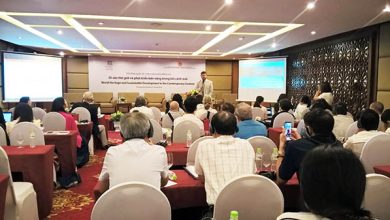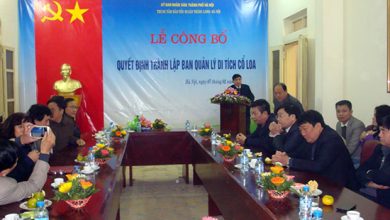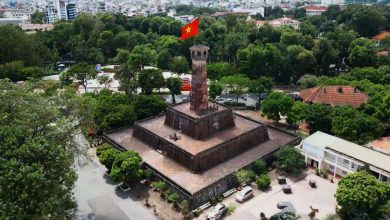Chính Đán (Main Tet) ceremony during Le dynasty according to various sources
I. Chính Đán Ceremony during the Le Dynasty according to various sources:
Chính đán was an important imperial court ceremony that took place on the first day of Tet, signifying a celebration for the king and members of the Royal Family. It was a grand court ritual held solemnly at the Kinh Thien Palace, expressing the desire for the nation’s prosperity, the longevity of the people, and creating an atmosphere of spring renewal. This marked a new beginning with hopes of good omens for the new year. During Chính đán Ceremony, representatives from all 12 regions of the country presented congratulatory tributes to the King. On this occasion, the King also distributed banquets and spring bonuses to civil and military officials, showing the King’s concern for his officials and reflecting a deep sense of humanity.
The Le Dynasty had strict regulations for officials participating in grand court ceremonies in general and the Main Tet Ceremony in particular. Historical records note: In the Canh Tuat year, [Hong Duc] 21st year [1490], (the third year of Minh Hoang Tri), in spring, January, after the large military assembly and review were completed, officials were allowed to return home, taking turns to stay for guard duty.
The regulation for local officials missing court appearances: those living nearby were required to return to court twice a year, while those from afar once a year. If they could not make it for the Chinh Dan Ceremony, they were allowed to come for the Thanh Tiet ceremony (Saint’s Day). Missing one occasion led to dismissal, and two times resulted in arrest and punishment.
Historical documents also record that during the Main Tet Ceremony, localities paid taxes to the court and prepared gifts to congratulate the king. During the reign of King Le and Lord Trinh, records by foreigners indicated that localities also congratulated the Lord, enforced as a strict regulation. Besides the regular taxes, which were unfairly applied regardless of one’s wealth (thus unjust), there were taxes on assets, artisanal incomes, and a form of voluntary, elegant tribute or actual support from each individual. These contributions, though not mandatory except for the poll tax, were due three or four times a year: the first at the end or beginning of the year as a Tet offering, the second to celebrate the Lord’s birthday according to tradition, the third on the anniversary of the Lord’s death, and the fourth during the early fruit season. However, these offerings were voluntary, and for the poll tax, it was mandatory. The entire province or village community would collaborate and select the most trusted representative to present these to the Lord on behalf of the entire community”[1].
The tradition of presenting gifts and offerings from inferiors to superiors on the first day of the new year has ancient origins. Nowadays, this practice is mandated by a strict law, making it obligatory for everyone. Officials, depending on their rank (and some, aiming for higher positions), send valuable gifts to the king annually. Lower-ranking officials present gifts to their superiors; students offer gifts to their teachers, and descendants to the family head, signifying the act of offering from those below to those they recognize as above them in hierarchy. “Due to the abundance and variety of gifts received, it is customary for officials to share a significant portion with relatives and friends during the year-end days, leaving some for servants and soldiers, allowing everyone to feel included in the celebration of Tet. The royal princes, having been on standby, cheer for the king first; followed by civil officials, then military officials. After that, the king retires to the palace to receive offerings from the queen, the consorts, the palace maids, and the servant girls. The queen performs her rites first, followed by others according to their rank, starting before dawn. A Trinh Lord also sends an official to the court to pay respects and offer congratulations to the king”[2].
- Venue of the ceremony: From the Van Tho Palace, the king is escorted to the Kinh Thien Palace for the ceremony.
- Ceremonial objects and music: In the Kinh Thien Palace and the Dragon Courtyard, the Emperor’s seat is placed in the center of the Kinh Thien gate, with the treasure bench to the East and the incense table in front of the seat; golden censers are placed on both sides of the seat. The Music Department arranges ceremonial music and grand music on the east and west sides of the Dragon Courtyard. The Guard Department arranges flags and weapons according to the ceremony. In the Ministry of Rites: the petitions from the provinces are placed in the central hall of the Ministry of Rites.
- Participants: The governors, high-ranking officials, and civil and military officials wearing their official attires. As the ceremony begins, high-ranking officials and officials from first to ninth rank enter the inner Dragon Courtyard, while the provincial officials and those presenting petitions remain outside the Doan Mon gate. The Ministry of Rites and the provincial officials directly prepare for the ceremony in the Ministry of Rites hall.
1.1. The Chính Đán Ceremony Rituals: Detailed in the Lịch triều hiến chương loại chí.
As one of the most significant grand court rituals of the royal court, the ceremonial objects and arrangements during the Chinh Dan Ceremony are solemnly organized.
Early in the morning, the governors, following the lord’s orders, bring high-ranking officials, civil, and military officers in their formal attires to offer congratulations.
- The Ministry of Rites officials and the provincial officials directly come to the Ministry of Rites hall. Waiting until the fifth watch of the morning, drums and music lead the way, night-duty officials carry the petition tablets, and the Guard Department covers them with golden censers. The Bureau of Instructions carries the petition tablets to the outside of the Doan Mon gate, placing them on the east side of the Dragon Courtyard (slightly to the north, where the officials carrying the petition tablets stand).
- At the first solemn drumbeat, civil and military officials (including managing officials and those presenting petitions) stand arranged outside the Doan Mon gate. At the second solemn drumbeat, the master of ceremonies leads the governor to a temporary seating area on the left side of the Dragon Courtyard. The managing officials (masters of ceremonies) proceed to the Van Tho Palace courtyard first, escort the king to the royal palanquin, called to the front, and perform a ritual of five bows and three kneels, after which they retreat to their previous positions on the east and west sides of the Dragon Courtyard. As the royal palanquin arrives at the Kinh Thien gate, the master of ceremonies leads the governor to stand on the east side of the Dragon Courtyard (slightly to the north), guiding the high-ranking officials and civil and military officers to line up on both sides of the Dragon Courtyard. The provincial officials and those presenting petitions are divided outside the Doan Mon gate.
- The king ascends the throne. The Music Department plays the “Van Quang” piece (celebratory music). After the bell and whip sounds (signaling a pause in music), tư thần lang (the timekeeper of the Imperial Observatory) announces the break of dawn with a proclamation: “Bài ban.” The master of ceremonies leads the governor to the position of homage. The master of ceremonies returns to his previous position. The heralds proclaim: “Grant audience.” Again they announce: “The palaces pay homage (celebratory music), repeated four times, normal state (pause in music).” Four officials from the Ministry of Rites carrying the petition tablets, covered by golden censers, move from the east side of the Dragon Courtyard east and west.
- The herald proclaims: “Announce the agenda.” The official tasked with announcing the agenda steps forward, declaring, “We are… Respectfully reporting: today, as we celebrate the main Tet holiday, we wish to present the congratulations of the princes, lords, literati, and officials from the royal ministries, Departments of Capital, Tribute, and Presentation from within the country, including all 12 provinces, and from specific regions such as Nghe An, Son Nam, Son Tay, Kinh Bac, Hai Duong, Thai Nguyen, Hung Hoa, Tuyen Quang, Lang Son, Yen Quang, totaling 11 provinces.” After the proclamation, they bow, stand up, and retreat to their previous position. The herald then directs: “All officials hand over to the announcing official, who, after reading, hands it back to the deputy official for presentation who then places it on the altar. The deputy official returns to his original position.
- The herald again proclaims: “Announce.” The announcing official moves to the center of the ceremonial path and kneels down. The herald commands: “All officials kneel.” The deputy official takes the deputy presentation from the presenting officials and places it on the altar. The deputy official then returns to his position. The herald announces: “Worship, flourish, be at ease.” The officials in charge of the ceremony lift the presentation and place it on the east side of the ceremonial path.
- The chief justice then kneels in the middle of the ceremonial path. The herald commands: “All officials kneel.” The chief justice reports: “By the emperor’s command, the governor of the water department and various domains, named…, along with princes, lords, and civil and military officials, obediently follow the lord’s orders, respectfully obeying: today, as we celebrate the main Tet holiday, we believe that the emperor, by heaven’s decree, has brilliantly handled the great affairs, coinciding with the main Tet, enjoying increased blessings. We are extremely joyful and wish to congratulate the king, wishing him a long life of thousands of years.”
- After reporting, they bow, stand up, and the transmitting official kneels in the center of the ceremonial path saying: “Submit the transmission,” bows, and remains kneeling. The official in charge of ceremonies hands the transmission to the transmitting official, who stands to the east, facing west, and declares: “There is a decree.” The herald commands: “All officials kneel.” The transmitting official reads: “The Emperor’s decree states: ‘May joy be as eternal as the heavens, shared with you all.’” After reading, they bring the decree to the center of the ceremonial path and kneel to present it. The ceremony’s official receives it, and the transmitting official stands up and returns to his previous position.
- The herald announces: “Worship, flourish, be at ease, perform the triple dance of the martial arts.” Again, they command: “All officials kneel, shout hoorays.” (At this point, all soldiers and the music band shout in unison.) Again, they announce: “Worship, flourish with the highest respect (celebratory music), flourish (four times), be at ease” (music stops). The ceremony’s official leads the governor to the east side, to the front. The herald announces: “All officials take their respective places.” The ritual department kneels in the middle of the ceremonial path: “The ceremony concludes.” The Music Department and the musicians perform the “Huu Ming” piece (celebratory music) as the whip sounds. The king returns to the palace. The ceremony’s official brings the presentation into the inner palace (music stops). The governor returns to his office. The officials depart in order.
1.2. The Main Tet Ceremony at the Lord’s Residence
The governor personally leads the relatives, high-ranking officials, and civil and military officials to the outside of the Cap Mon gate, all in their full regalia, belts, and hats, ready to enter the residence. Four inspectors (using the educational system), two standing on the left and right inside the residence, and two outside the residence. The Lord ascends the throne. The governor arranges for the civil and military officials to proceed from outside to inside the residence. The governor offers congratulations, followed by the officials in order, and then they attend the banquet. After the thanksgiving ceremony, the Lord enters the inner palace, and the governor returns to his office. The civil and military officials then visit the governor’s residence to offer their congratulations according to the ritual.
The practice of hosting a banquet for the court on Tet, although held at the Lord’s Residence and decreed by Lord Trinh, with increasingly limited funds allocated to the Le King, merely sufficient to maintain activities within the royal palace, signified that the real power was in the hands of the Lord. This tradition of hosting Tet banquets was not unique to this period but can be traced back to the Ly-Tran dynasties, although the rituals were not yet clearly defined. By the early Le dynasty, in 1435, the king held banquets over five days for civil and military officials both inside and outside the palace and distributed money to civil and military officials according to their ranks[3].
Historical sources also describe the granting of rewards to officials on the Main Tet day. The Tet New Year’s Day work protocol. The guard teams, and boat squads such as Nhung Nhat, Kieu Nhat, Noi Nhung, and Noi Kieu were in attendance. The boat teams Noi Khuong, Noi Duc, Noi Due, Noi Tiep, Thi Han, Thi Tuong, Thi Ki, Thi Ma, Noi Sieu, Noi Tuyen, Noi Uu, Noi Trach were observers, all wearing uniforms made of hemp. After the ceremony, the military alternates counted the number of officials to distribute money according to rank:
- First rank received 5 quan of precious money; Second rank received 4 quan; Third rank received 3 quan; Fourth rank received 2 quan; Sixth and Seventh rank received 1.5 quan; Eighth and Ninth rank and civil and military officials like Pho Tri, Them Tri, Cau Ke received 1 quan.
- Those without rank but part of the Guard, Internal Supervision; those with rank but not part of the Guard followed the Subordinate officials. Chief stewards, deputy chief stewards, leaders of teams like Thi Nhung, Thi Nhi, Thi But, Thi Phien, Thi Dai Dai, Thi San, Thi Cac, Thi Lau, Thi Noi Van, Nhung Nhat, Kieu Nhat, Noi Nhung, Noi Kieu, and deputy managers of the Ty Thien Giám received 6 mach of precious money.
- Thi Kieu received 3 mach, with an additional 1 mach and 4 van of precious money.
- Internal officials; Subordinate officials, team leaders of teams like Nhung Nhat, Kieu Nhat, Noi Nhung, Noi Kieu, Subordinate officials, Chief team leaders, Deputy team leaders, leaders of the internal palanquin teams, managers of the Ty Thien Giám received 3 mach of precious money.
- Văn chức (civil officials), Thần lang, Ty Thien Giám, Subordinate officials, and Team leaders of the middle banner teams received 2 mach of precious money.
- Guards of Ty Thien Giám and the internal soldiers received 1 mach of precious money[4].
II. Steps in Organizing the Chính Đán (Main Tet) Ceremony:
2.1. Preparation Work
The Main Tet Ceremony during the Le Dynasty was held at the Kinh Thien Palace. To prepare for this event, every year, 12 congratulatory documents were compiled by princes, lords, literati, and military officials, including those from regions such as Thanh Hoa, Nghe An, Son Nam, Son Tay, Kinh Bac, Hai Duong, Thai Nguyen, Hung Hoa, Tuyen Quang, Lang Son, Yen Quang. These documents contained new year greetings for the king.
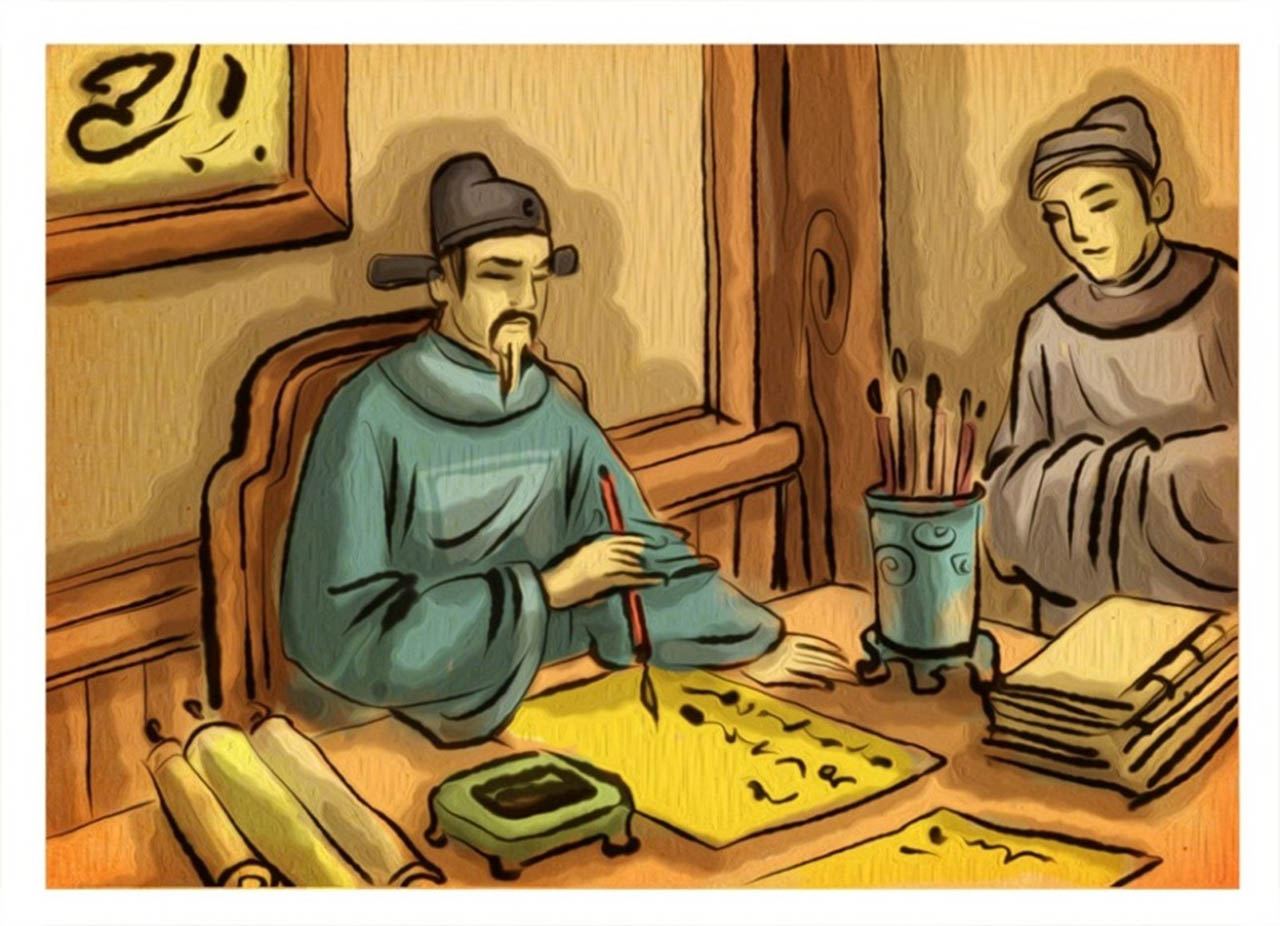
2.2. Preparation by the Ministry of Rites
The Ministry of Rites, assigned by the royal court, was the primary responsible organization for preparing the Main Tet Ceremony. The ministry prepared a list of tasks and requested funding from the Ministry of Finance. Close to the day of the ceremony, the Ministry of Rites prepared the ceremonial space, participants, and rituals meticulously. The royal court also strictly regulated participation in the Main Tet Ceremony: a local official from nearby areas was required to attend the court twice a year, while those from afar, once a year. If unable to attend the Main Tet Ceremony, they were allowed to come on the Saint’s Day. Missing once resulted in dismissal, and twice, in arrest and punishment.
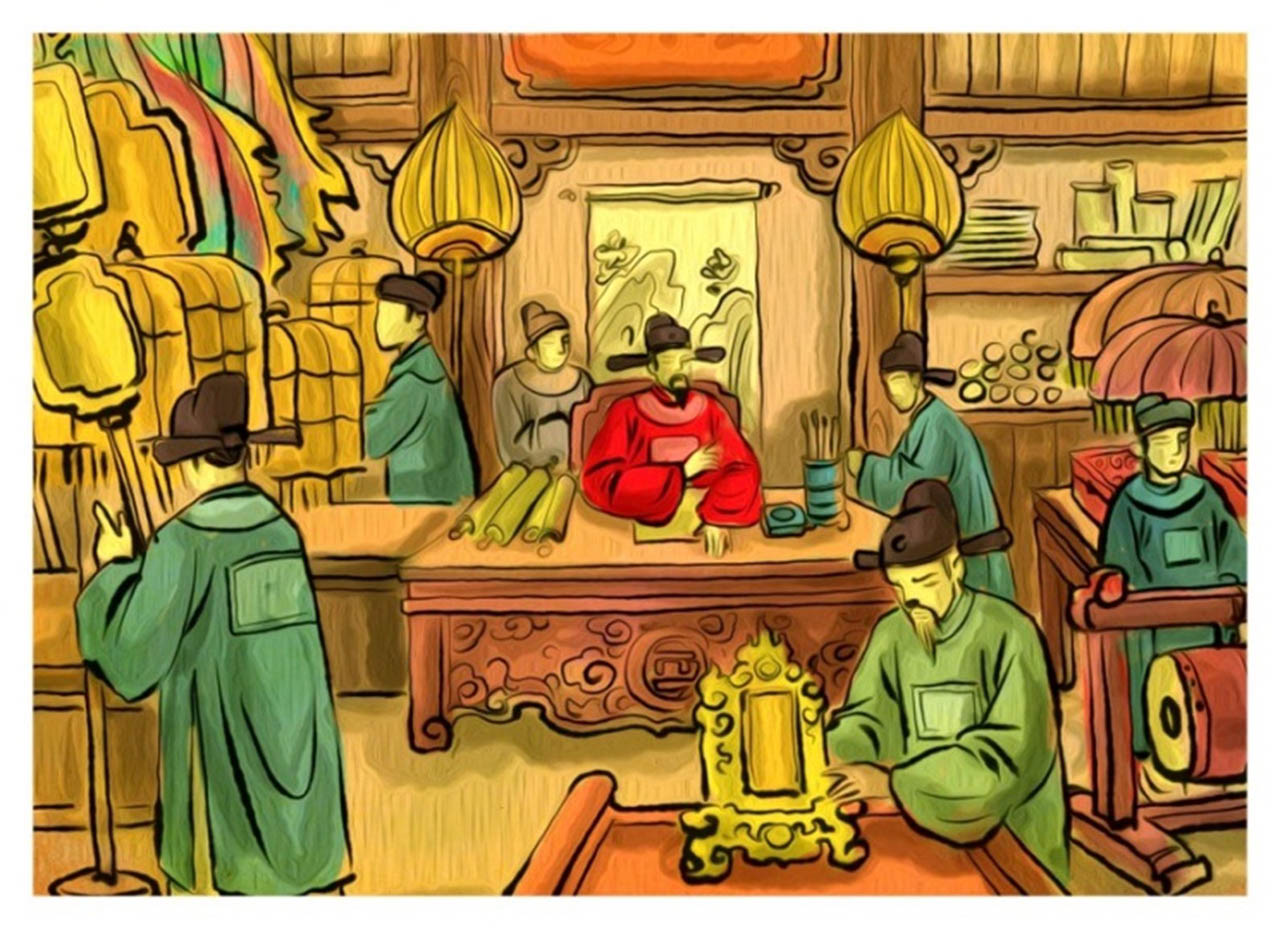
2.3. Preparations Before the Main Tet Day
All these congratulatory documents were collected at the Ministry of Rites to prepare for the Main Tet Ceremony. The ministry was tasked with copying a version of the document for the ritual of presenting it to the king at the Kinh Thien Palace courtyard. Before the Main Tet Day, officials prepared the petitions to be kept at the Ministry of Rites. Officials from the Ministry of Rites and provincial officials stayed overnight at the Ministry of Rites, waiting to attend and offer Tet greetings to the king.

2.4. Procession of the Petitions to the Kinh Thien Palace Courtyard
When the fifth watch of the night arrived, with drums and music leading, night-duty officials carried the petitions, covered by the Guard Department with golden censers, followed by civil and military officials in a solemn procession towards the Forbidden City of Thang Long.
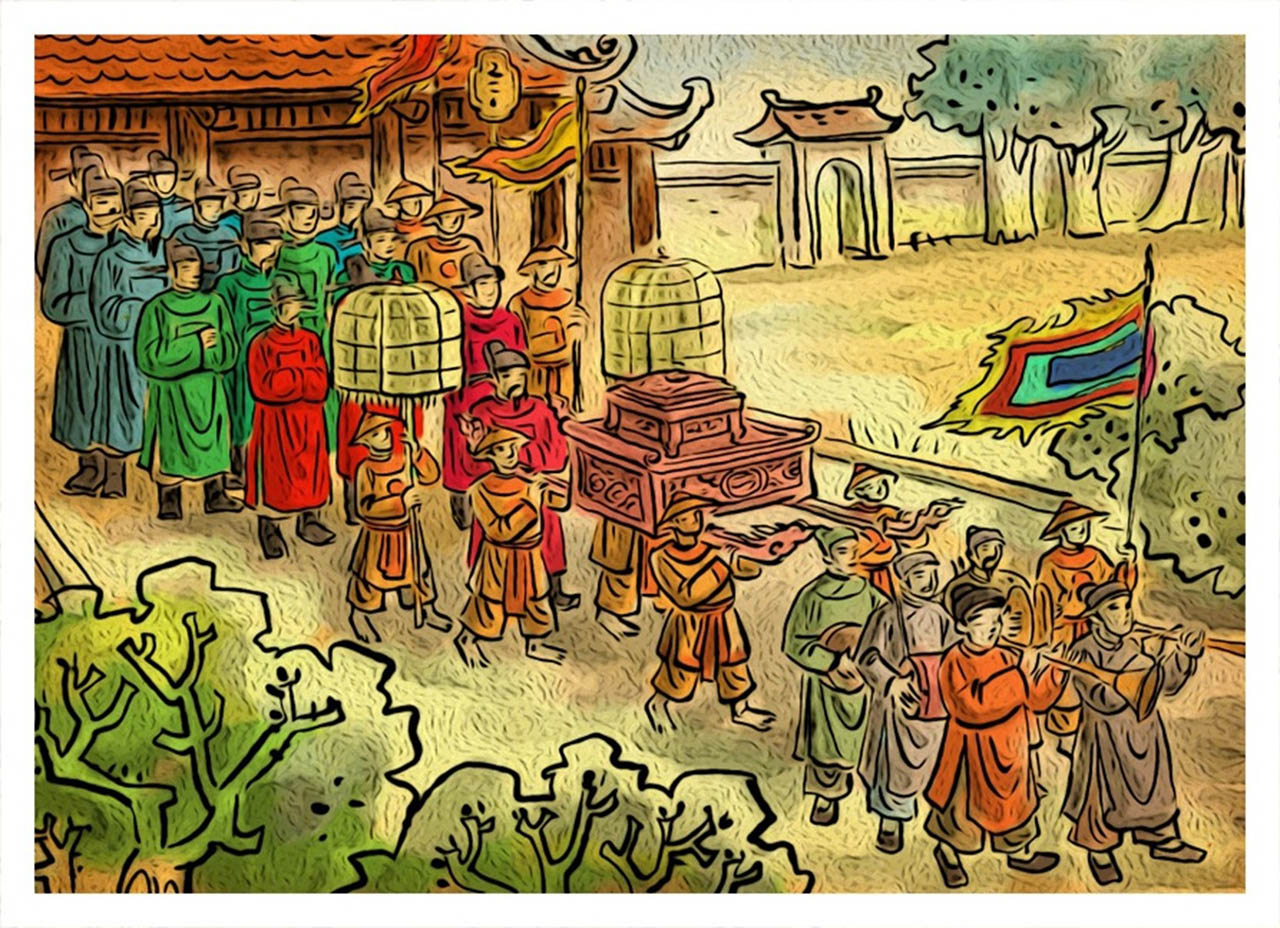
2.5. Officials Enter the Doan Mon Gate
The Bureau of Instructions carried the petitions to the outside of the Doan Mon gate, placing them on the east side of the Dragon Courtyard (slightly to the north, where the officials carrying the petitions stood). At the first solemn drumbeat, civil and military officials (including managing officials and those presenting petitions) were arranged outside the Doan Mon gate.
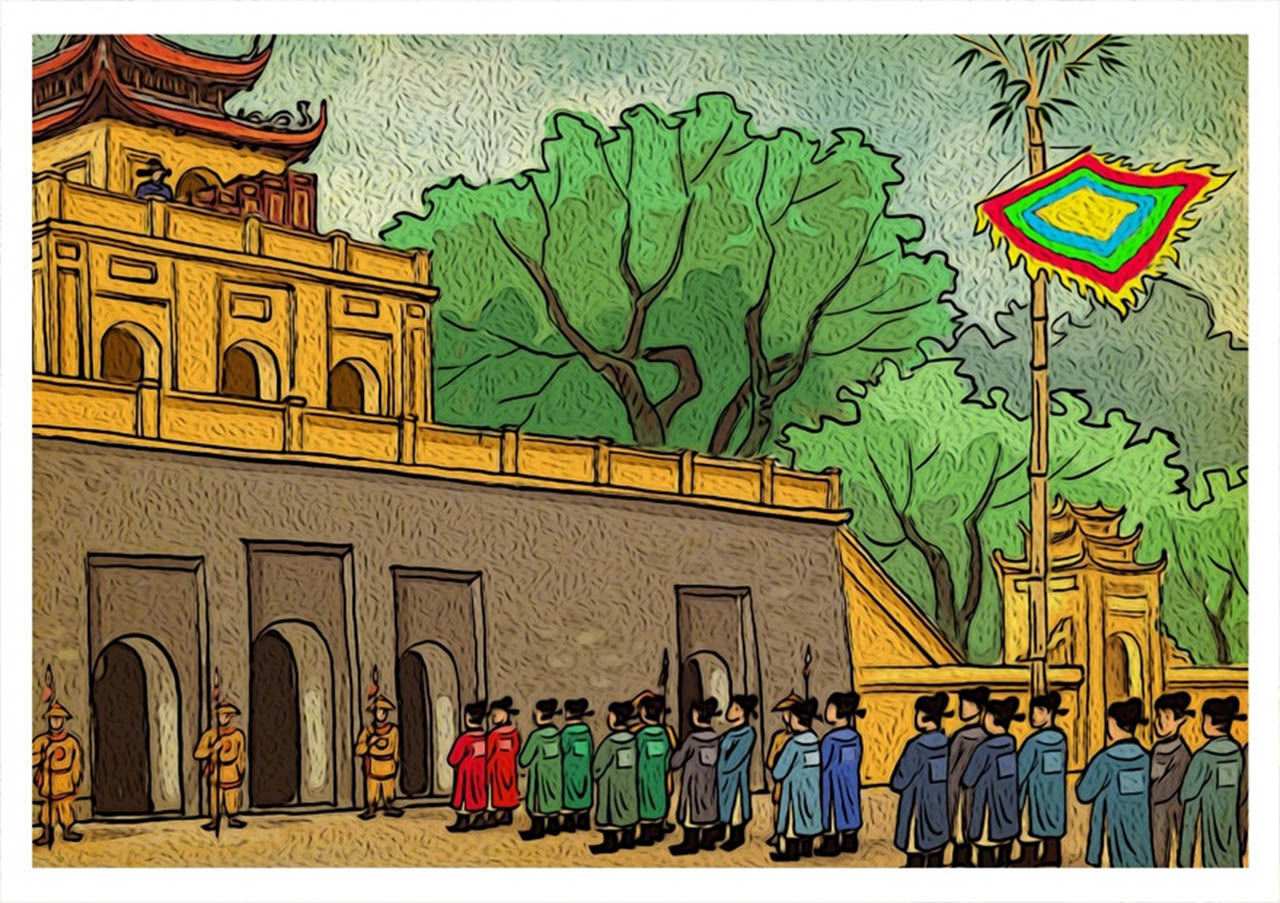
2.6. Announcement of Firecracker Orders
Every New Year, from mid-December of the previous year, the Military Alternates prepared, and the Ty Thien Giám was instructed to choose an auspicious time and direction to announce. On the 30th, the Thiên Hùng signal was set, and gunpowder was distributed. At the appointed time, upon receiving the order, firecrackers were launched, and the ceremony at the Kinh Thien Palace was performed. This was especially meaningful for the Main Tet Ceremony as it marked the beginning of the new year with hopeful prospects.

2.7. Officials Escort the King from Van Tho Palace to Kinh Thien Palace
At the second solemn drumbeat, the master of ceremonies led the governor to a temporary seating area on the left side of the Dragon Courtyard. The managing officials (masters of ceremonies) proceeded first into the Van Tho Palace courtyard, escorted the King to the royal palanquin, and then were summoned to the front at the Kinh Thien Palace to perform a ritual of five bows and three kneels. After the ceremony, they retreated to their previous positions on the east and west sides of the Dragon Courtyard.
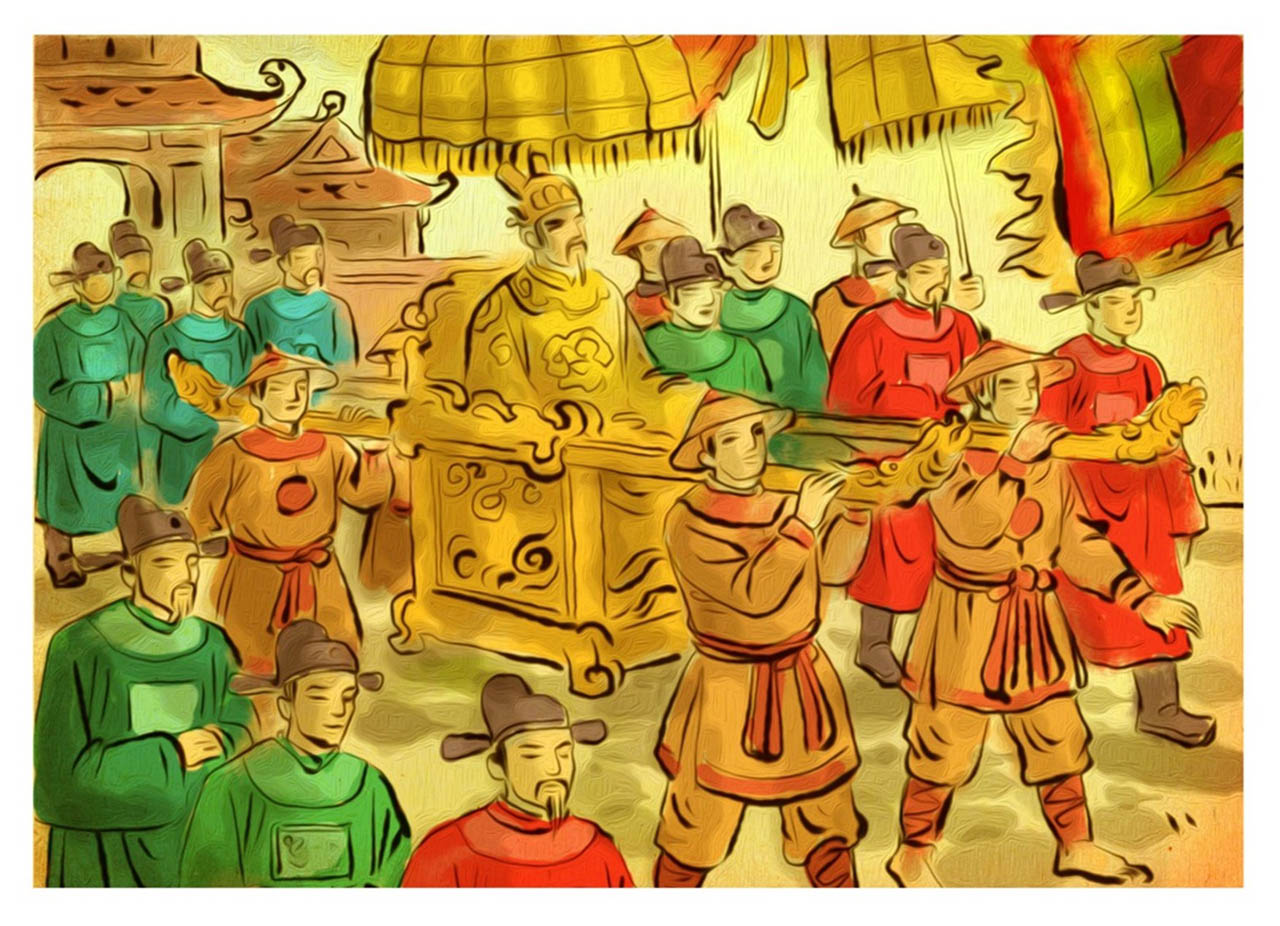
2.8. The King Ascends the Throne at Kinh Thien Palace
Upon the king’s arrival at the Kinh Thien gate, the master of ceremonies led the high-ranking officials and civil and military officers to line up on both sides of the Dragon Courtyard. Provincial officials and those presenting petitions were divided outside the Doan Mon gate. The King ascended the throne. The Music Department played the “Van Quang” piece.
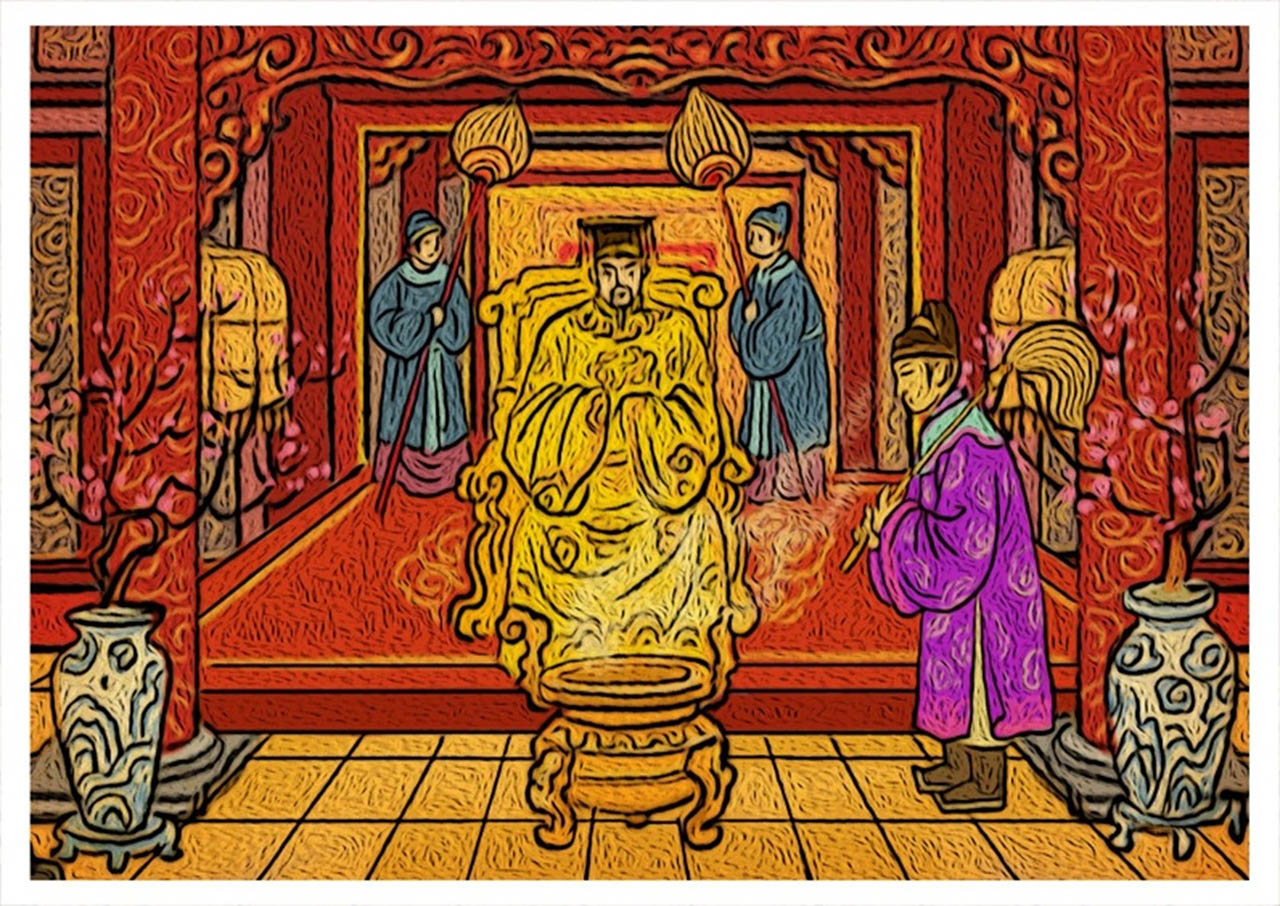
2.9. Civil and Military Officials Perform Ceremonies in the Dragon Courtyard
After the bell and whip sounds (indicating a pause in music), heralds announced the start of the “Decree” – officials positioned themselves accordingly, aligning in rows neatly. The master of ceremonies led the governor to the homage position. The master of ceremonies then returned to his previous position. Heralds proclaimed: “Grant audience” – two groups of civil and military officials faced and oriented towards the Kinh Thien Palace. They then announced: “Perform the highest respect” (celebratory music), “repeat four times, be at ease” (music stops) – officials knelt, bowed, touched their heads to the ground four times, and then stood up straight.

2.10. Announcement of the Agenda and Speeches
The official responsible for announcing the agenda kneels in the middle of the ceremonial path to request permission to present the 12 congratulatory documents from princes, lords, literati, military officials, and the Departments of Capital, Tribute, and Presentation. Following this, the Chief Justice, representing the civil and military officials, offers congratulations to the King: “On this Main Tet, we, your loyal subjects, believe that Your Majesty, by the decree of Heaven, holding great responsibility, encountering this Main Tet, enjoys increased blessings. We are extremely overjoyed and offer our congratulations, wishing His Majesty a long life of thousands of years.”

2.11. Announcement of the Decree
After the announcement of the agenda and speeches is the announcement of the decree. The official responsible for transmitting the decree kneels in the center of the ceremonial path to receive the decree from the official in charge of ceremonies. All civil and military officials kneel solemnly. The official reads the King’s decree: “The Emperor’s decree states: ‘May joy be as eternal as the heavens, shared with you all.’”

2.12. The King Returns to the Palace to Receive Congratulations
All civil and military officials perform a congratulatory ceremony for the King, shouting “Long live the king, long live, long live the king.” Afterward, the official in charge of rituals kneels to conclude the ceremony. The official in charge of ceremonies carries the petitions into the inner palace. After the Main Tet Ceremony at the Kinh Thien Palace is completed, officials visit Lord Trinh’s Residence to offer congratulations. The King returns to the palace to receive congratulations from the queens and concubines.
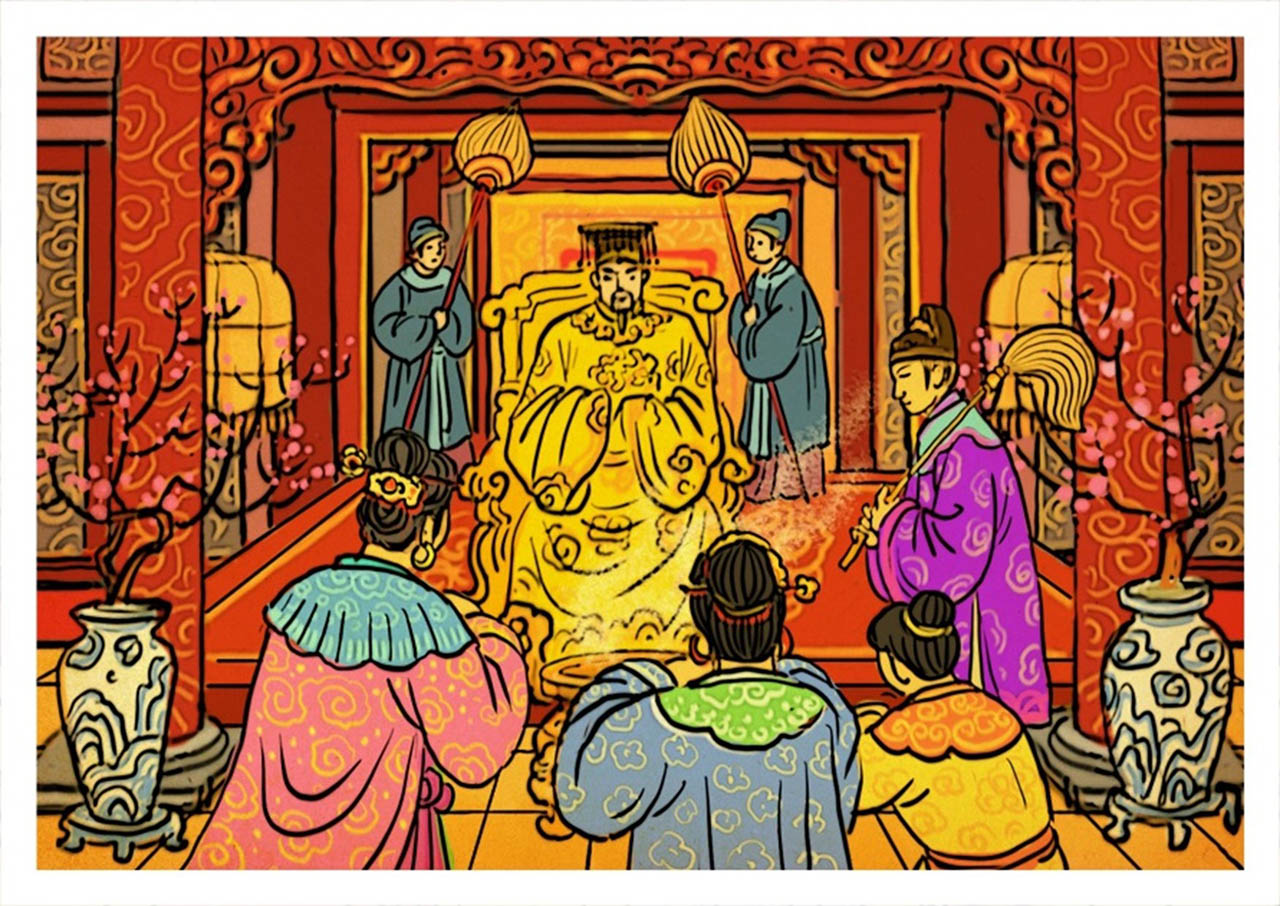
2.13. Officials Receive Rewards
Every Tet, the Le Dynasty’s royal court issued an order to distribute spring monetary rewards to civil and military officials. There were two types of rewards: spending money and larger commemorative coins. The commemorative coins, larger and exquisitely decorated with dragon, phoenix, cloud patterns, etc., were strictly regulated according to rank.

2.14. Officials Receive Banquet Invitations
On Main Tet, the King distributed monetary rewards and organized a banquet to entertain the court, with the arrangements for this banquet handled by a department under the Ministry of Rites, funded by the Ministry of Internal Affairs. The distribution of spring monetary rewards and the banquet underscored the King’s concern for his officials, reinforcing unity within the court and demonstrating a deep sense of humanity.
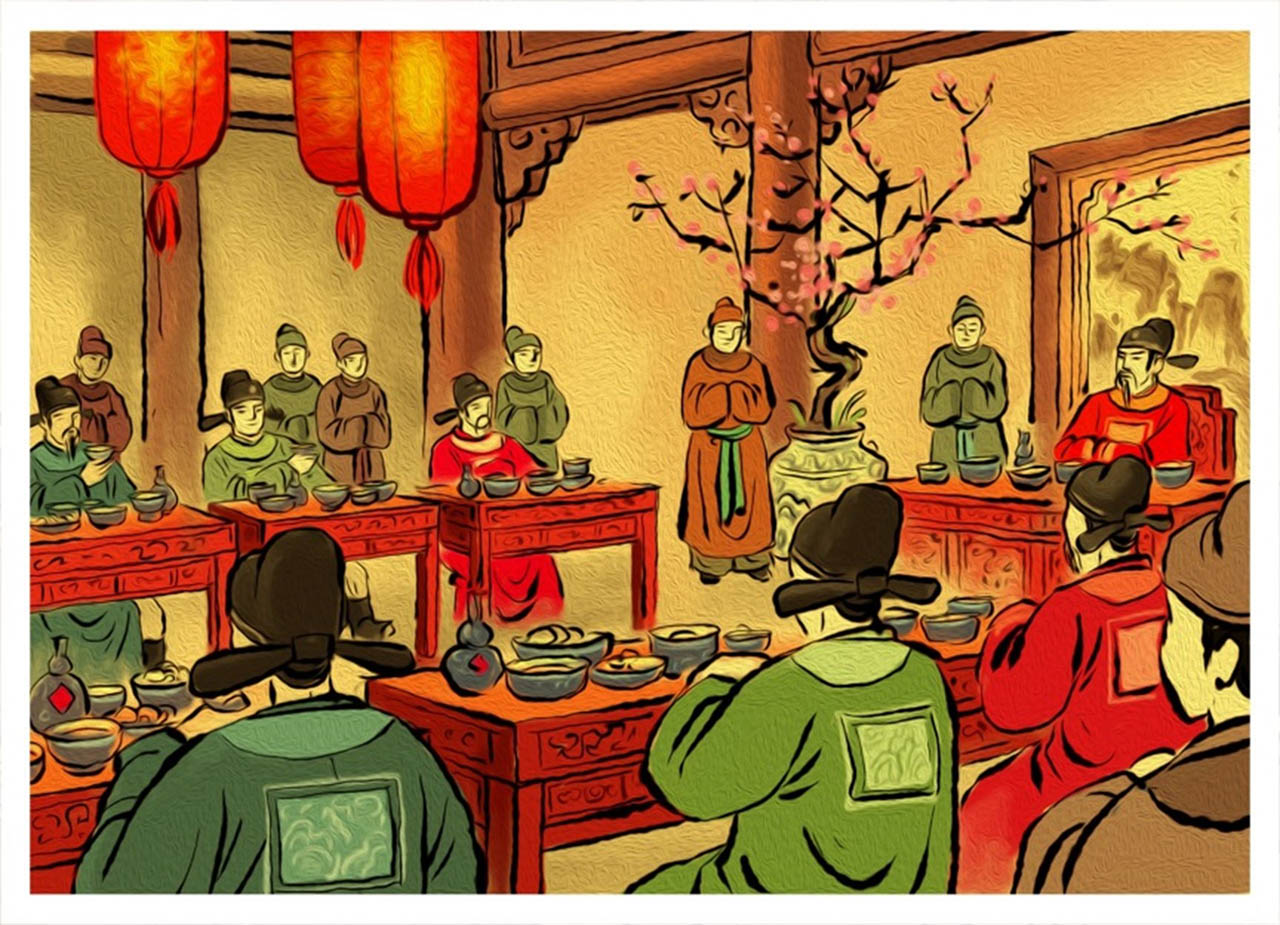
Department for Heritage Research and Collection

